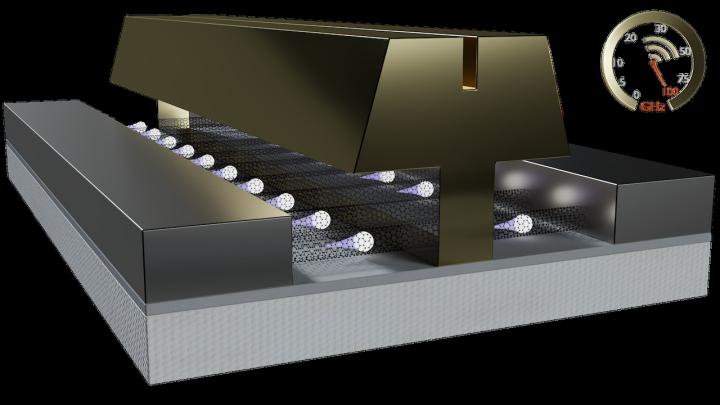
Credit: Carbonics, Inc.
RESEARCH TRIANGLE PARK, N.C. (Nov. 21, 2019) — An Army-funded project may boost 5G and mm-Wave technologies, improving military communications and sensing equipment.
Carbonics, Inc., partnered with the University of Southern California to develop a carbon nanotube technology that, for the first time, achieved speeds exceeding 100GHz in radio frequency applications. The milestone eclipses the performance — and efficiency — of traditional Radio Frequency Complementary Metal-Oxide Semiconductor, known as RF-CMOS technology, that is ubiquitous in modern consumer electronics, including cell phones.
“This milestone shows that carbon nanotubes, long thought to be a promising communications chip technology, can deliver,” said Dr. Joe Qiu, program manager, solid state and electromagnetics at the Army Research Office. “The next step is scaling this technology, proving that it can work in high-volume manufacturing. Ultimately, this technology could help the Army meet its needs in communications, radar, electronic warfare and other sensing applications.”
The research was published in the journal Nature Electronics.
The work, funded by ARO, an element of U.S. Army Combat Capabilities Development Command’s Army Research Laboratory, is a part of a Small Business Technology Transfer Program. The program focuses on feasibility studies leading to prototype demonstration of technology for specific applications.
For nearly two decades, researchers have theorized that carbon nanotubes would be well suited as a high-frequency transistor technology due to its unique one-dimensional electron transport characteristics. The engineering challenge has been to assemble the high-purity semiconducting nanotubes into densely aligned arrays and create a working device out of the nanomaterial.
Carbonics, a venture backed start-up, and USC, successfully overcame this challenge. Projections based on scaling single carbon nanotube device metrics suggest the technology could ultimately far exceed the top-tier incumbent RF technology, Gallium Arsenide.
Carbonics employs a deposition technology called ZEBRA that enables carbon nanotubes to be densely aligned and deposited onto a variety of chip substrates including silicon, silicon-on-insulator, quartz and flexible materials. This allows the technology to be directly integrated with traditional CMOS digital logic circuits, overcoming the typical problem of heterogeneous integration.
“With this exciting accomplishment, the timing is ripe to leverage our CMOS-compatible technology for the 5G and mm-Wave defense communication markets,” said Carbonics’ CEO Kos Galatsis. “We are now engaged in licensing and technology transfer partnerships with industry participants, while we continue to advance this disruptive RF technology.”
###
In 2014, Carbonics spun-out from the joint center of UCLA-USC and King Abdulaziz City for Science and Technology in Saudi Arabia called the Center of Excellence for Green Nanotechnologies.
The research is based in part, on work funded by the Army more than 10 years ago at University of California Irvine. A graduate student who worked on that project for his doctoral thesis research, Dr. Christopher Rutherglen, is now Carbonics’ chief technology officer.
The CCDC Army Research Laboratory is an element of the U.S. Army Combat Capabilities Development Command. As the Army’s corporate research laboratory, ARL discovers, innovates and transitions science and technology to ensure dominant strategic land power. Through collaboration across the command’s core technical competencies, CCDC leads in the discovery, development and delivery of the technology-based capabilities required to make Soldiers more effective to win our Nation’s wars and come home safely. CCDC is a major subordinate command of the U.S. Army Futures Command.
Media Contact
Lisa Bistreich-Wolfe
[email protected]
919-549-4372
Original Source
https:/
Related Journal Article
http://dx.




